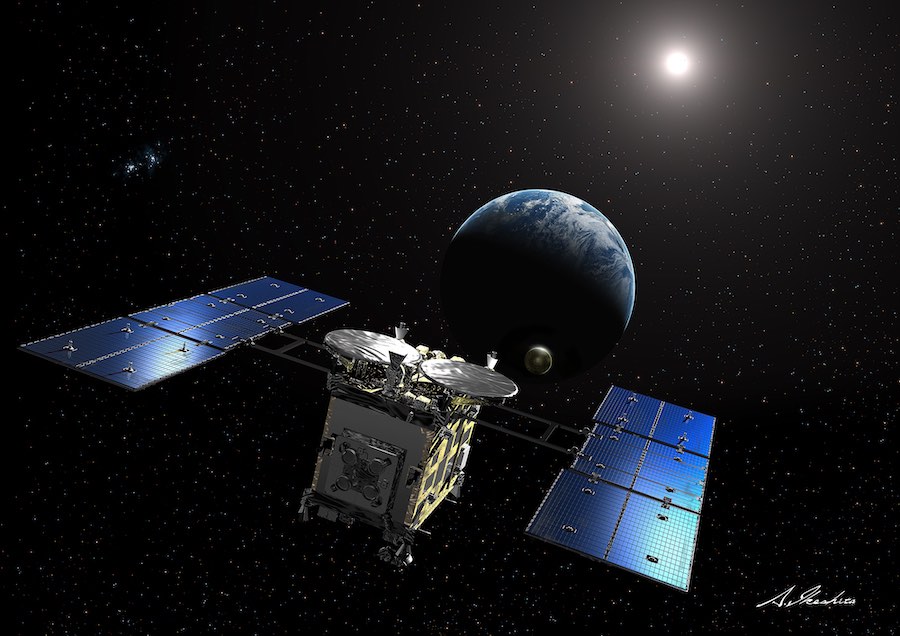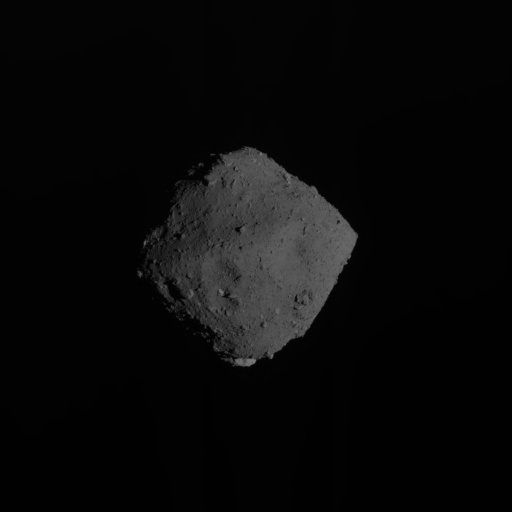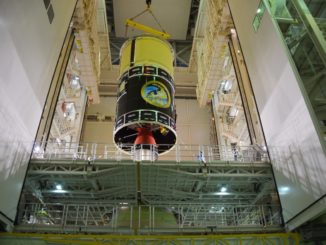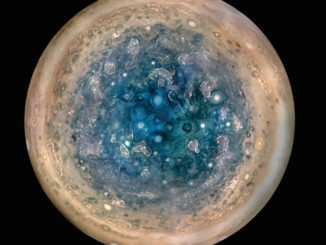
A capsule carrying extraterrestrial specimens collected by Japan’s Hayabusa 2 spacecraft is scheduled for landing in South Australia on Dec. 6 to wrap up a six-year round-trip mission to an asteroid, officials announced this week.
Officials from the Japan Aerospace Exploration Agency, or JAXA, and the Australian Space Agency said Tuesday they are preparing for the return of Hayabusa 2 in December.
The Hayabusa 2 spacecraft will release a sample return canister as it approaches Earth, then divert itself away from the planet and continue into space. Protected by a heat shield, the nearly 16-inch-diameter (40-centimeter) return capsule will plunge into the atmosphere at more than 26,000 mph (43,000 kilometers per hour) and deploy a parachute for a soft landing in Australia.
Like Japan’s first Hayabusa mission, which returned microscopic asteroid specimens in 2010, Hayabusa 2’s landing capsule will aim for landing in the Woomera Prohibited Area in South Australia.
“The successful return of Hayabusa in 2010 is a great example of achieving shared ambition with international counterparts through partnership,” said Megan Clark, head of the Australian Space Agency, in a statement. “This activity again highlights the role Australia can play in the growing space economy. We look forward to working with JAXA, and encouraging entrepreneurship while ensuring our activities are safe, in space, and on Earth.”
JAXA and the Australian government will cooperate to prepare for the return of Hayabusa 2. The Australian Space Agency said it will coordinate licensing requirements for the landing of the Hayabusa 2 sample carrier, which will include an Authorization of Return of Overseas Launched Space Object from the Australian government.
The Australian military, which oversees operations at the Woomera Range Complex in South Australia, will provide support and access to the Hayabusa 2 landing zone, officials said.

The Hayabusa 2 mission’s return to Earth has been planned for late 2020 since the spacecraft’s launch from Japan in December 2014 aboard an H-2A rocket. The spacecraft reached Ryugu, half-mile-wide (900-meter) asteroid that crosses Earth’s orbit, in June 2018 after a journey of three-and-a-half years.
The spacecraft dropped a fleet of landers and rovers to the explore the asteroid’s surface, then approached Ryugu for two touch-and-go-landings in 2019 to gather rock fragments from two different locations. During one of the sample collection maneuvers, Hayabusa 2 descended into an artificial crater created by an explosive impactor released by the spacecraft, allowing the probe to gather material from the asteroid’s subsurface.
Scientists are eager to analyze the specimens, which they expect may contain organic molecules. Researchers believe asteroids like Ryugu, or a larger body like the one from which Ryugu split off, could have seeded Earth with materials necessary for life.
Hayabusa 2 departed Ryugu in November 2019 to begin the year-long trip back to Earth. The probe uses ion thrusters to reshape its trajectory through the solar system, aiming for arrival back at Earth in December.
Officials on Tuesday confirmed the probe’s return date of Dec. 6, Australian time. The landing of the sample capsule will complete a round-trip mission spanning more than 3.2 billion miles (5.2 billion kilometers).
“Successfully realizing this epoch-making sample return mission is a great partnership between Australia and Japan and will be a symbol of international cooperation and of overcoming the difficulties and crisis caused by the pandemic,” JAXA and the Australian Space Agency said in a joint statement Tuesday.
As of this week, Hayabusa 2 was located around 57 million miles (92 million kilometers) from Earth, and the probe’s ion engines had generated more than half of the impulse needed to steer the spacecraft on its return journey.

While Hayabusa 2’s mission operations team in Japan continue guiding the spacecraft on its voyage home, scientists are also gearing up for the task of retrieving the asteroid specimens from the the return canister and carrying them from Australia back to Japan for analysis.
Mission planners designed Hayabusa 2 to collect at least 100 milligrams of material from asteroid Ryugu. Engineers have no way of measuring the contents of the sample canister until it returns to Earth, but they are confident the spacecraft gathered the required material due to the near-perfect performance of the sampling system during the touch-and-go landing runs last year.
Hayabusa 2’s mission has stood in contrast to Japan’s Hayabusa mission, which encountered numerous problems during a seven-year mission to asteroid Itokawa in the 2000s. Hayabusa made it back to Earth, but a malfunction of its sample collection system meant it returned with a tiny fraction of the intended specimens.
A recovery team in Australia will locate the Hayabusa 2 sample canister with the help of a radio beacon, then secure it for a flight to Japan, where scientists will transfer the capsule into an ultra-clean curation facility. Researchers will open the canister and extract the asteroid specimens for analysis with sophisticated laboratory instruments.
Email the author.
Follow Stephen Clark on Twitter: @StephenClark1.



